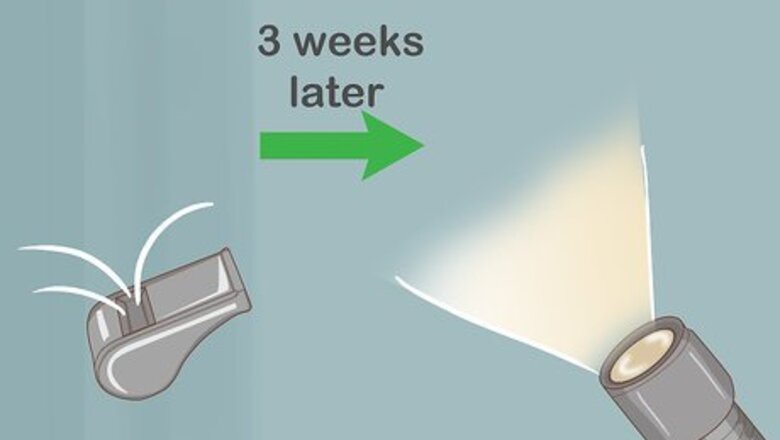
views
Scaring Away Deer
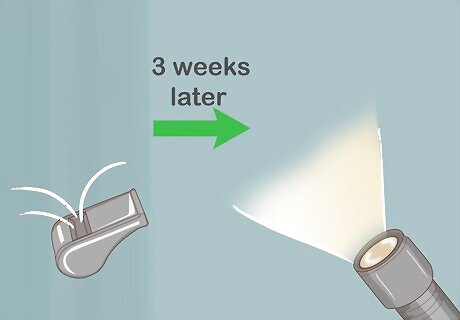
Use flashing lights or loud noises to startle deer. Blow a horn or whistle or blink a flashlight if you see deer in your yard. You can also get sensors that emit high-pitched noises when they detect movement. Keep in mind you will need to change your method at least every 3 weeks as deer will quickly adjust to any 1 method. For example, if you're using a whistle, after 3 weeks, switch to the flashlight. Try hanging old CDs or aluminum foil from trees or shrubs. The flashing lights from the CDs and rustling noise of the foil help deter deer. Wind chimes rattling in the breeze or a flashy garden accessory with moving parts like a pinwheel are both decorative ways to keep deer away.
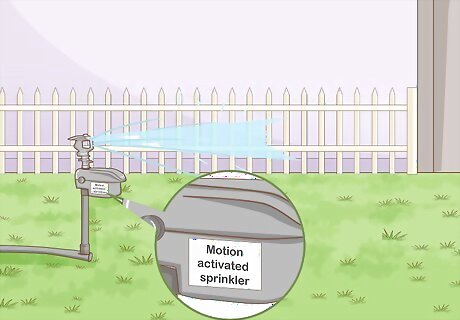
Set up a motion-activated sprinkler system that will spray deer. These sprinklers go off when they detect any movement, like a deer stepping into your garden. Place them anywhere you don't want deer. However, the sprinklers only work in the warmer summer months because they'll freeze up in the winter. Look for a sprinkler with an infrared sensor that will detect motion at night, too. Move your sprinkler around every couple of weeks so the deer don't become used to it or learn how to avoid it.
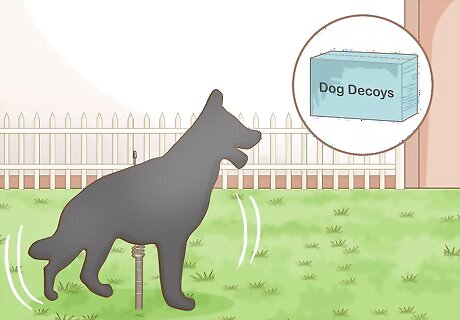
Let your dog out in the yard or set up a dog decoy if you don't have a pet. Deer are afraid of predators like dogs and are likely to steer clear if they suspect one is nearby. Keep Fido outside more often or stake a silhouette of a dog in the yard. Even the decoy will frighten deer. Scattering dog hair on the ground around specific plants and trees or around the perimeter of your garden gives off the scent of a predator to deer, scaring them off. Decoys of any predators, like owls, coyotes, or hawks, will work. You can buy decoys that move, too, which are even more effective. Keep your dog's safety in mind. Don't leave your dog outside if it's raining or really cold. Smaller dogs shouldn't be left unsupervised for long periods of time, either, if there are birds of prey in your area.
Repelling Deer with Scents
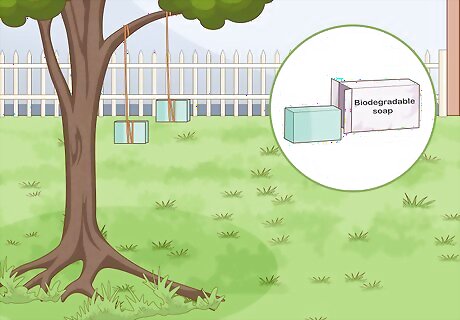
Hang bars of biodegradable soap from trees you don't want to get eaten. Wrap a bar of soap in burlap and tie it to a tree branch in the backyard. The tallow in the soap is unappealing to deers' noses. Stronger scents are more effective in deterring deer. Just avoid soap with coconut oil, which can attract deer. If you don't like the look of soap hanging in the trees, sprinkle soap shavings around the base of plants or trees instead.

Spray a commercially prepared repellent on plants the deer have targeted. Choose from odor sprays or taste sprays. Odor sprays can be sprayed over a larger area, like around the border of your yard. Taste sprays, on the other hand, are applied to a single plant, tree, or shrub. The liquid tastes and smells bad to deer, so they stop eating the plant. Check to make sure the product is safe to use for vegetable and fruit bearing plants if you are using it on a garden or fruit trees. Spray it at night when you aren't in the yard so you don't have to be around the odor.

Spread coyote urine so that deer think a predator is nearby. Buy the urine from an online retailer and spray it in any areas you want to keep deer away from. Keep in mind that a little goes a long way. For example, just 2 to 3 drops on 1 plant is enough. You can also get urine granules that you sprinkle onto the soil. Bobcat urine is a common alternative to coyote urine because bobcats are another predator of deer.
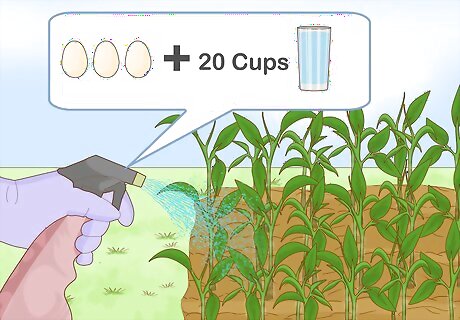
Apply an egg spray to make plants smell unappealing. Beat 3 eggs with 20 cups (4,700 ml) of water in a mixing bowl. Pour the mixture into a spray bottle, and spray the plants every 30 days or after it rains. The sulfur from the egg smells like rotting meat, which the deer associate with predators. Spray the plants on a dry day so the mixture sticks better to the leaves. Smells That Keep Deer Away Mint Cinnamon or cloves Citrus Hot peppers Dish soap Garlic Blood meal
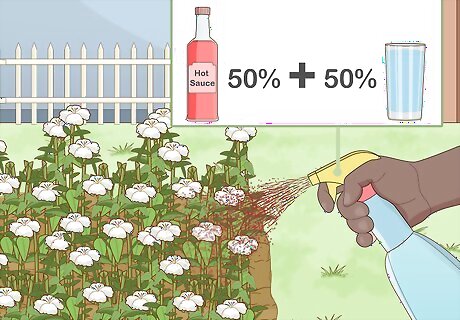
Use a spray made with diluted hot sauce to irritate deer. Combine equal parts hot sauce and water in a spray bottle and shake thoroughly before applying to plants or tree leaves. The capsicum from the peppers in the hot sauces tastes bad to the deer, causing them to stop eating the plant. Adjust the ratio of hot sauce to water however you'd like. The more hot sauce you include, the stronger the repellent will be.
Preventing Deer from Returning

Build a fence at least 8 feet (2.4 m) around your property to keep deer out. Most deer cannot jump higher than this. Deer are also more hesitant to jump over a fence if they don't know what's on the other side so a stockade-style fence works best. Make sure there are no gaps that a deer could squeeze through. A double fence also deters deer. They don't like to be trapped or enclosed, so two fences built about 3 to 5 feet (0.91 to 1.52 m) apart will prevent deer from jumping. If you don't want a fence around your entire yard, just fence in the plants or shrubs you want protected from the deer. A tall hedge or row of dense shrubs can act as a natural fence.
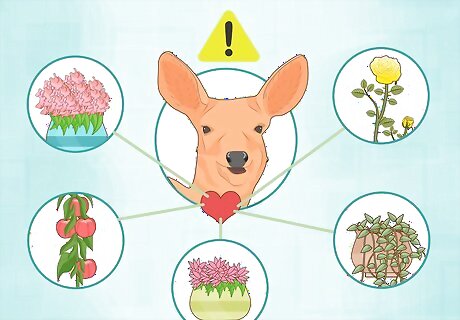
Avoid planting smooth and tender plants that deer love to eat. Deer enjoy things that are flavorful, sweet, or high in protein. Some of their favorite foods include fruit trees and bushes, bean or pea plants, English ivy, and pansies. The more of these plants you have, the more likely you are to attract deer. Other flowering plants that deer like are roses, azaleas, chrysanthemums, and clematis. If you do want to plant these things, keep them close to the house so you can keep tabs on them.
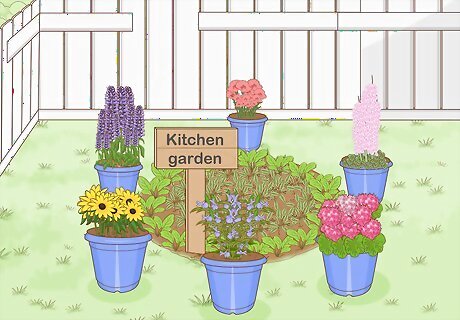
Plant deer-resistant plants around vegetation the deer are targeting. Deer are very sensitive to tastes and textures. They dislike plants that are hairy or furry, prickly, or strongly aromatic. Keep deer away from more delicious plants by surrounding them with these less appealing plants. Examples of deer-resistant plants include foxgloves, black-eyed susans, carnations, poppies, lavender, and evergreens. Place pots of fragrant herbs like thyme or rosemary around your yard to repel deer.
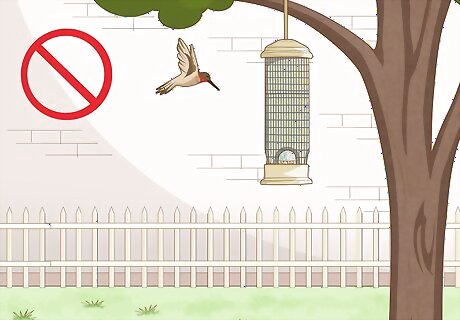
Remove bird feeders from your yard, at least at night. Bird seed or corn that you place out for other animals will also draw deer to your property. If you don't want to get rid of your bird feeders completely, put them inside in the evening and then take them back out in the morning since deer most commonly eat at night. Another option is to place a mesh cage around the bird feeder or hang it high enough that a deer standing on its hind legs can't reach it.



















Comments
0 comment